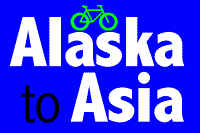Germany
We left England on a beautiful June day and spent our last day cycling past summer
meadows, hedgerows filled with flowers and strawberry fields. A 24-hour ferry ride
took us to Hamburg. We whizzed through Germany in 4 days, initially past cobbled
market squares and traditional schlosses but then past concrete tower blocks and huge
factories in the former East Germany, ever present reminders of its communist past.
The map we had was 15 years old so the borders between East and West were marked
and names such as Karl-Marx-Stadt were still used, much to the amusement of
German cyclists that we met.
The Czech Republic
Much of the Czech countryside was tree covered rolling hills. Our first stop was
Pilsen where we had the total beer experience. We visited the beer museum to look at
the history of brewing, then did a tour of the current Pilsen beer factory and finally we
sampled the local brew in a Czech beerhouse. Towards Prague we took the direct,
well paved road with large shoulder only to be stopped half way by the police who in
broken German told us that it was a motorway and illegal for cyclists. They then
mentioned a fine, at which point we had difficulty understanding their poor German
and they let us leave at the next exit. Prague was exceptionally beautiful and we had
the good fortune to be hosted by an old Brunel University contact - Jan and his wife
Petra.
Slovakia
Crossing the border, changing money and changing language seemed quite strange to
us when the 2 countries were very similar. Most Slovakians however wanted a
separate state with a Slovakian identity. The highlight of Slovakia was meeting 3
Polish nuns driving the wrong way down a dual-carriage way (separated highway)
who stopped to ask us directions. We rested the bikes for a day in the High Tatras and
climbed a 2400m peak for great views across Slovakia and Poland.
Hungary
Hungary was one of the most economically advanced countries (along with the Czech
Republic) that we saw in Eastern Europe. The countryside was flat and agricultural
and the towns full of historic buildings. This was the furthest west that we saw traces
of the Ottoman Empire and the furthest East that we saw traces of the large Western
Supermarket Empire (a huge Tesco). Hungarians are famous for their horsemanship
and we were bounced through the forest on the back of 2 of their famous beasts.
Romania
Entering Romania was like taking a step back in time. We shared the road with
horses and carts. Many old farming methods were still used such as drying hay and
turning it by hand and cutting grass with scythes. Romania was also where we met
several tricksters all trying devious ways to get our money - one scam was to say ĎAhh
you are from England. Iíve never seen a £50 note before. Do you have one that I can
look at?í As you produce the note, it and the inquirer disappear without trace. (NB
We were not conned in this way!) We visited Brasov, a narrow cobbled-alley
medieval town where Dracula is said to have hung out and Bran Castle the inspiration
for Bram Stokerís book.
Bulgaria
In our final European country the landscape was getting dryer and the number of
mosques greater. We visited the capital Sofia, a bustling modern city with a mixture
of Eastern Orthodox and Islamic historic buildings. One of the most beautiful
buildings we visited in Europe was the Rila Monastery, tucked up in the Rila
mountains. The original monastery was built 1000 years ago, and time here seems to
have stopped in the middle ages.
Our highlights of Eastern Europe were the historic towns - notably Prague, the Rila
Monastery and Brasov, and the natural beauty of the High Tatras, Rila and Carpathian
mountains. We were now looking forward to Asia!

